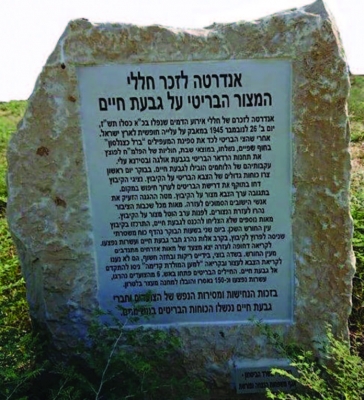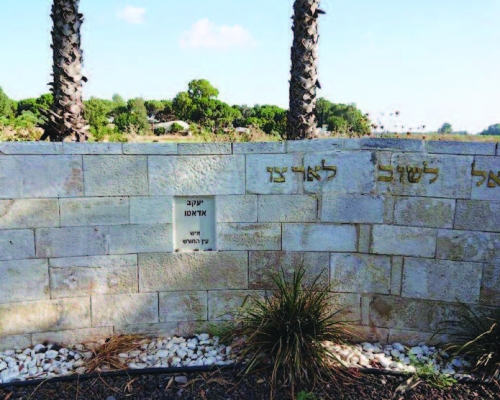Memorial to Those Who Died in Siege
An impressive memorial to eight Jews killed by British soldiers on the 26th November, 1945 sits at the end of a dry, dusty, bracken-filled field between the kibbutzim of Givat Haim and Ein Hahoresh in the Hefer Valley near Hadera.
At the side of the main road between the two kibbutzim a large brown sign points to an off road path. The sign, a recognizable Israel Historical and Heritage site marker, simply reads "Memorial to the Eight". Having no idea of the background to the memorial, and it not being seen from the main road itself, a detour is made and the story of "the Eight" learned.
A meter and half high semi-circular wall hewn from yellow tinted white rock contains panels where the name of each of the fallen is inscribed in black letters, and underneath is the name of the Jewish community in the yishuv from which that person came.
Behind the wall, also in a semi circle, a line of thin-trunked but very tall palm trees swish gently to and fro in the breeze. On either side of the flimsy looking palms, even taller fir trees stand.Unlike the palms, the firs stand firm, motionless, like sentinels guarding the memory and heroism of those fallen whose names are marked at the site in stone, and in history books.
Two large signs, embedded in rock, tell the story of what led up to that fateful day when eight unarmed Jews were gunned down by British soldiers in a swampy field. One of the signs is affixed to the end of the semi-circular wall, and the other, fashioned from a large similarly hewn yellow-tinged rock, stands like a guardian at the gate but some 50 meters away on the approach track.
The events that led up to that tragic day began with the arrival of an illegal immigrant ship named after Berl Katznelson (the ship was originally named the Dimitrius). Over 200 would-be immigrants were on deck - most of whom were from Greece, others from eastern Europe, many having survived German concentration camps, others having fought in the resistance. And also among them were youngsters making their way to the Promised Land through Youth Aliya.
Discovered by the British off-shore from Kibbutz Shfayim, most of the would-be new immigrants and those who had come to assist them disembark, dispersed in a number of directions, entering and blending in with those living in established Jewish communities in the region. However, some of the members of Palyam (the naval wing of the Palmach) and passengers were caught, arrested and sent to Latrun prison and the Atlit camp.
In retaliation against the British arrests, units of the Palmach were sent to blow up the British coastal police stations and radar bases of Sidni Ali and Givat Olga. The tracks of the Jewish perpetrators led the British to the 1932 founded Givat Haim where they demanded to be allowed in to search for any possible illegals and the Palmachniks.
"Yitzhak Ben Aharon, a member of Givat Haim, who had served in the Jewish Brigade and seen as a godfather of the kibbutz movement, met with the British commanders and told them point blank they would not be allowed to search Givat Haim and so a siege began", this writer later learns from Yonat Rotbain, whose father Avi Marle was one of those pioneers who founded Ein HaHoresh just a year before others founded Givat Haim on a hill a short distance away.
"A call went out for help but people couldn't enter Givat Haim so they gathered in large numbers in our kibbutz Ein Horesh to await orders. On the second day of the siege the order came and hundreds marched, unarmed to Givat Haim", explained Yonat, a researcher at the Moreshet Center for Holocaust Research and Documentation at the nearby educational campus of Givat Haviva.
When the marchers approached Givat Haim, in what was then still a mosquito breeding, mud filled swamp, the British forces ordered them to stop.
The marchers refused, surged forward chanting "Forward for the sake of the country" and the soldiers opened fire.
Apart from those who died, scores were wounded, many others arrested and taken to Latrun prison.
"As children in Ein HaHoresh we grew up on the stories of that terrible day, of the bravery shown by the marchers against the British soliders - and every year as Israel's Remembrance Day for the Fallen approaches, a ceremony is held at the Memorial of the Eight situated between our kibbutzim", explains Yonat.
"Shimon Kaminer, a founder of Ein Hahoresh and father of two daughters, was seriously wounded that day and brought back to the kibbutz on a stretcher. One of his then young daughters saw them carrying the stretcher and recognized her fathers shoes", says Yonat sadly, adding that Shimon Kaminer suffered greatly from his wounds and eventually died some years later as a result of the injuries sustained trying to break the siege.
"He was basically the ninth victim of that day", she adds.
One of the names on the memorial's circular wall is that of Yaacov Adato, Ein HaHoresh written underneath. Apparently Yaacov had made it to British Mandatory Palestine from Turkey and was with a group of his peers living and working on the kibbutz. He was just 18 years old when he died alongside the others as they tried to break the siege of Givat Haim, the name of the kibbutz translating to "The Hill of Life."









Comments 1
My name is Dr. Peter Lubrecht and I am an author presenter researching my cousin Jan Baeck who changed his name to Honzo David Ben Shalom . His Mother was my great-aunt Magdelena Ficke from Oldenburg i.O in Germany. She married Alexander Baeck , the grand Nephew of Rabbi Leo Baeck ,(yes the famous one). The marriage certificate lists him as Evangelical but he was Jewish, He was originally form Hungary; they left Germany in 1911 or so and son Jan was born in 1912 in Ostrava Czech Republic . His brother Tomas was born in 1916. Alexander was a paper salesman. All I knew growing up in New York City was Tante Magdelena married a Jew and they moved to Czechoslovakia. 1950 my 5th grade class was studying puppetry and I received three puppets from I thought was from cousin Jan in the Czech Republic. I learned later that was somewhere near Tel Aviv in Israel. Thanks to the internet I found that Cousin Jan was then Honzo David Ben Shalom in the kibbutz Hivat Haim and became an internationally known puppeteer.
I since have found his book, and newspaper articles. I am looking for information about his migration to Israel (1934 ) ND HIS FAMILY AND THOS WHO KNEW HIM. My family would have nothing to do with him -I think-he was in the U.S. to make a movie King Boor -He is buried on the grounds of Kibbutz Hivat Haim Mehued (?). His puppets are in Tel Aviv University.
I have a Power Point called the Rabbi and the Puppeteer which I will be presenting Jan 27 2025 and it will be on You Tube through the Hacketstown Museum website. I can send you the file.
I am looking for information on Honzo. my email is olpete.lubrecht@gmail.com my web site is Olpeteshistory.com
Thank you in advance
Pete Lubrecht